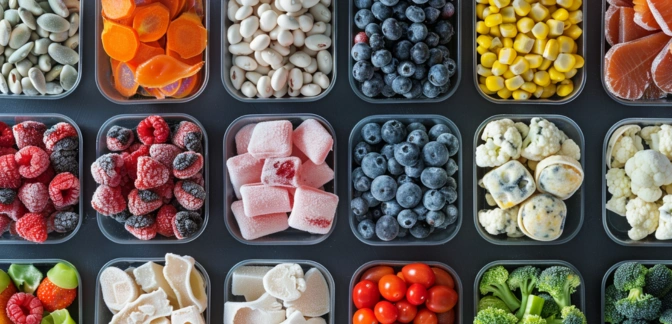Frozen Spinach — Nutrients, Health Benefits, And Shopping Tips

Written by Listonic Team
Last update on September 4, 2024
Nutrition facts
Nutrition facts
Amount per 100 g
Calories
🔥 23 kcal
| Nutrition per: 100 g | Value | % Daily Value* |
|---|---|---|
| Carbs | 4 g | 1.45% |
| Fiber | 2 g | 7.14% |
| Sugars | 0 g | - |
| Glycemic Index | 15 | - |
| Protein | 3 g | 6% |
| Sodium | 79 mg | 3.43% |
| Total Fat | 0 g | - |
*The % of Daily Value (DV) tells you how much a nutrient in a serving of food contributes to a daily diet. 2,000 calories a day is used for general nutrition advice.
23
🍏 Low-Calorie Foods
15
🟢 Low Glycemic Index
Did you know?
Health benefits
- Rich in vitamins and minerals such as Vitamin A, Vitamin C, Vitamin K, and folate, which support overall health and well-being.
- High in antioxidants, which help protect the body from free radicals and reduce inflammation.
- Supports bone health due to its high Vitamin K content, which is important for bone density and strength.
- Supports eye health due to the presence of lutein and zeaxanthin, which help maintain good vision.
Health risks
- Potential for contamination with harmful bacteria, such as E. coli or Listeria, particularly if the spinach is not properly handled, stored, or cooked to a safe internal temperature.
- Risk of nutrient loss as some vitamins and minerals may degrade during the freezing process, particularly if the spinach is not properly stored.
- Digestive discomfort such as bloating or gas when consumed in large quantities due to its high fiber content.
- Potential for pesticide residue on conventionally grown spinach, which can pose health risks if not properly washed before freezing.
How to choose frozen spinach
Frozen spinach is convenient and nutritious if processed correctly. The leaves should be vibrant green and not clumped together. Examine the bag for tears or holes which can compromise the quality.
Avoid frozen spinach that has turned an olive or brown color, as this can indicate overprocessing. Good quality frozen spinach should retain its color and nutritional value after cooking.

How to store frozen spinach
Frozen spinach should be stored in the freezer until ready to use. Keep it in its original packaging or transfer to a freezer-safe bag. Properly stored, frozen spinach can last up to a year.
Air exposure can lead to freezer burn, affecting its quality. Frequent thawing should be avoided. Ensure the packaging is well-sealed to maintain its nutritional value and flavor, providing the best results when cooked.
✅ Extra Tip
How long does it last?
Frozen spinach can last for 9-12 months in the freezer when stored in an airtight container or freezer bag. To maintain its quality, keep it at a consistent freezing temperature.
What to do with leftovers?
Leftover frozen spinach can be used in a variety of dishes, both as a side or main ingredient. Thaw and sauté it with garlic and olive oil for a simple side dish, or mix it into a pasta dish with a creamy or tomato-based sauce. Spinach is also great in quiches, frittatas, or omelets, where it adds flavor and nutrition.
Use frozen spinach in a casserole with cheese and breadcrumbs, or blend it into a spinach soup for a creamy, comforting dish. If you have a lot of frozen spinach, consider making a batch of spinach and cheese stuffed shells, where the spinach adds a healthy twist. Spinach can also be added to a grain bowl with quinoa or rice, or used as a topping for pizzas or flatbreads. For a quick snack, mix thawed spinach with cream cheese and herbs for a simple spinach dip, perfect for serving with crackers or vegetables.
👨⚕️️ Medical disclaimer
Discover products from other categories
Listonic Team
Fact-checked
Our editorial team checked this article to make sure it was accurate at the time of publishing it.
Get the top-rated shopping list app

frozen spinach
1 piece







